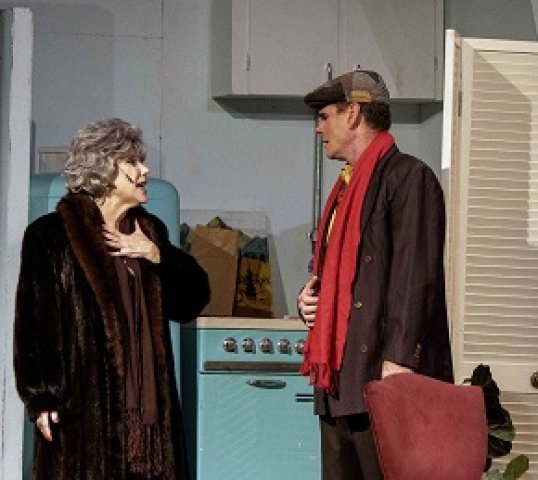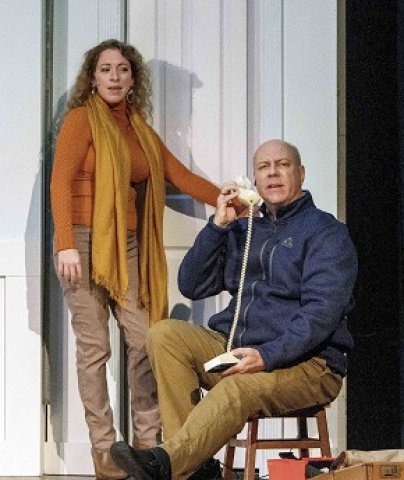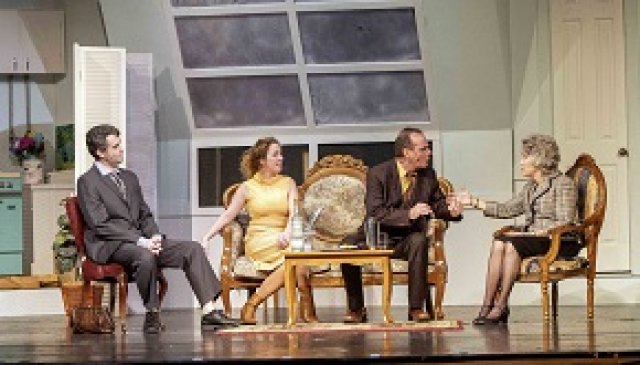Barefoot in the Park
Pembroke Pines Theatre of the Performing Arts in South Florida
By: Aaron Krause - Jan 28, 2024
Imagine if everybody in the world married like-minded individuals. Perhaps divorces would become a thing of the past, conflicts between couples would cease, and complete harmony would reign in all married couples’ homes.
But wouldn’t marriage become boring? After all, variety is the spice of life, as the saying goes. We should try new things, meet new people, etc. And if opposites do indeed attract, then marrying someone different than yourself should be the obvious thing to do, right?
Paul and Corie Bratter apparently knew that. They are the couple at the center of Neil Simon’s amusing 1963 play Barefoot in the Park. And their story ends happily since this is a comedy. But the Bratters begin arguing soon after they settle into married life, resulting in plenty of laughs. Come see for yourself; Pembroke Pines Theatre of the Performing Arts (PPTOPA) has mounted a humorous and believable professional production of Simon’s award-winning hit. The two-hour production, which includes a 15-minute intermission, runs through this weekend at the Susan B. Katz Theater at River of Grass Arts Park in Pembroke Pines.
The production stars talented performers who fully inhabit their characters. And, to their credit, they play their parts with sincerity. That, along with deft comic timing, bring out the comedy in the piece.
Under Seth Trucks’ solid direction, Stephen Keenan plays Paul Bratter while Sara Grant portrays Corie Bratter. Meanwhile, Christopher Dreeson inhabits the role of the newlyweds’ eccentric neighbor, Victor Velasco. In addition, Francine Birns takes on the part of Corie’s mother, Ethel Banks. Also, Greg Schuh and Jose Norono bring a telephone repairman and a delivery man to life, respectively.
Barefoot in the Park takes place in New York City during the 1960s. The title is symbolic. Literally, Corie asks her new husband to walk barefoot in the park. But the play’s title also symbolizes the idea of living a daring, adventuresome life by stepping out of your comfort zone and trying new things. However, Paul is not the type of person who takes risks and seeks different adventures. Indeed, he is tense, reserved, conservative, and practical. Contrastingly, Cori is loose, free-spirited, energetic, optimistic and adventurous. In addition, she is impulsive. She acts without thinking about how others feel about her plans. And that is when chaos can erupt between the couple.
When the play opens, the newlyweds have just spent a blissful six days at New York’s Plaza Hotel for their honeymoon. All was rosy. However, now they are about to settle into real life in their new home, a five-story walk-up apartment. It is far from ideal. First, everybody is out of breath by the time they walk up all those stairs. Additionally, there is a hole in the ceiling big enough to allow precipitation to enter their apartment. As though that is not enough, the closet is leaky, and there is no bathtub or heat.
Under these humorous circumstances (it’s funny, especially if you often experience schadenfreude), can the Bratters exist together in peace and continue to love each other till death do them part?
The disharmony begins after Corie decides to hook her mother up with Velasco. Apparently, his landlord locked him out since he wasn’t paying rent. Therefore, he must enter his attic apartment by climbing out of Corie’s bedroom window and scaling a narrow ledge outside the building. You’re liable to start laughing once you learn about Velasco’s situation, especially if something similar happened to a person you know. Or, perhaps you are the one guilty of failing to pay your rent. In that case, you may laugh and squirm at the same time.
Velasco is a comical man. He is charming, polite, enthusiastic, and flamboyant, qualities that cast member Dreeson nails. In addition, the actor speaks in a believable accent that suggests the man hails from somewhere in Europe. As the performer portrays Velasco, he is a polite gentleman who kisses women’s hands.
Velasco, 56, has been married three times and enjoys travel, skiing, mountain climbing, hot coffee, bath robes, thick rugs, and cooking in his gourmet society. Of course, his lifestyle contrasts markedly from the lives that many of us lead, a fact that adds to the play’s comedy.
But Velasco isn’t the only comedic character. Cori’s mother can also be funny, although she’s more like her conservative son-in-law than her adventurous daughter.
“I had to park the car three blocks away,” mom says soon after entering her daughter’s new apartment. “Then it started to rain so I ran the last two blocks. Then my heel got caught in a subway grating. When I pulled my foot out, I stepped in a puddle. Then a cab went by and splashed my stockings. If the hardware store downstairs was open, I was going to buy a knife and kill myself.”
In PPTOPA’s production, Francine Birns speaks the aforementioned words with enough sincerity that we laugh. Birns, who looks younger than her character’s actual age, is not only humorous, but also finds the humanity in the part. For instance, Birns convinces us that she is a loving mother who combines humor with wisdom.
“Make him feel important,” Banks tells her daughter. “If you do that, you’ll have a happy and wonderful marriage – like two out of every 10 couples.”
Certainly, we witness glimpses of the Bratters as a loving couple. For example, at least once, Cori runs into Paul’s arms, he lifts her up in an embrace, and they kiss. During another scene, Cori sits on Paul’s lap and they hug and kiss.
As the play’s main couple, Keenan and Grant share a strong chemistry. It becomes clear that they love each other despite their differences – or maybe, in the final analysis, because of their differences.
Grant injects Corie with a youthful energy and a zest for living that is contagious. She moves across the stage quickly and with purpose like a child excitedly entering a toy store during Christmas. Grant’s Corie is also seductive.
“I’ll keep you warm and there’s no charge for electricity,” Corie tells her husband after he mentions how cold it is in the apartment. Apparently, the radiator does not work.
But while Grant’s Corie can be loving, she can also become hysterical, almost to the point of overacting.
Meanwhile, Keenan portrays Paul with restraint. But while he is clearly quieter, more tense, and less enthusiastic than Corie, Keenan ensures that his character is never a dull individual. Undoubtedly, Keenan’s Paul is a loving, dignified husband who wants the best for his wife. He dives into his work as an attorney not just for himself, but to provide for him and his wife.
Rounding out the cast, Greg Schuh and Jose Norono provide comic moments as a telephone repairman and a delivery man, respectively.
As the director, Trucks pays attention to detail. For instance, during at least one scene, the director has mother and daughter seated next to each other and on the same level (both low to the ground). This suggests a close bond between the women. Also, when Grant’s Corie acts childish, she folds her arms in a gesture that suggests stubbornness.
While the acting is strong, so is the behind-the-scenes work. As an example, scenic designer John Blessed has created a realistic-looking depiction of the newlyweds’ apartment. It sports vibrant colors such as white, blue and reddish-brown. The colors make the apartment look inviting despite the issues that need fixing.
Alicia Rivera designed the period appropriate costumes, while Michael Graham created the realistic lighting.
Barefoot in the Park was only the second of more than 30 plays the prolific Simon wrote throughout his long and widely productive career. Yet, the play received four Tony Award nominations, including for Best Play. Ultimately, the piece captured one Tony Award in 1964 for Best Direction of a Play.
Simon knew how to capture the humor in everyday situations. The late playwright, who began his career writing for television, became widely known for his comical one-liners. But over time, his plays became meatier with more depth. Simon’s characters and situations are relatable because they remind us of our own lives.
Barefoot in the Park might be mostly an escapist play. But while we laugh, this play makes us look at our own imperfections and relationships with others.
Chances are, Simon would have been proud of PPTOPA’s mounting of Barefoot in the Park.
Pembroke Pines Theatre of the Performing Arts’ production of Barefoot in the Park concluded on Jan. 28 at the Susan B. Katz Theater of the Performing Arts at the River of Grass ArtsPark in Pembroke Pines.



